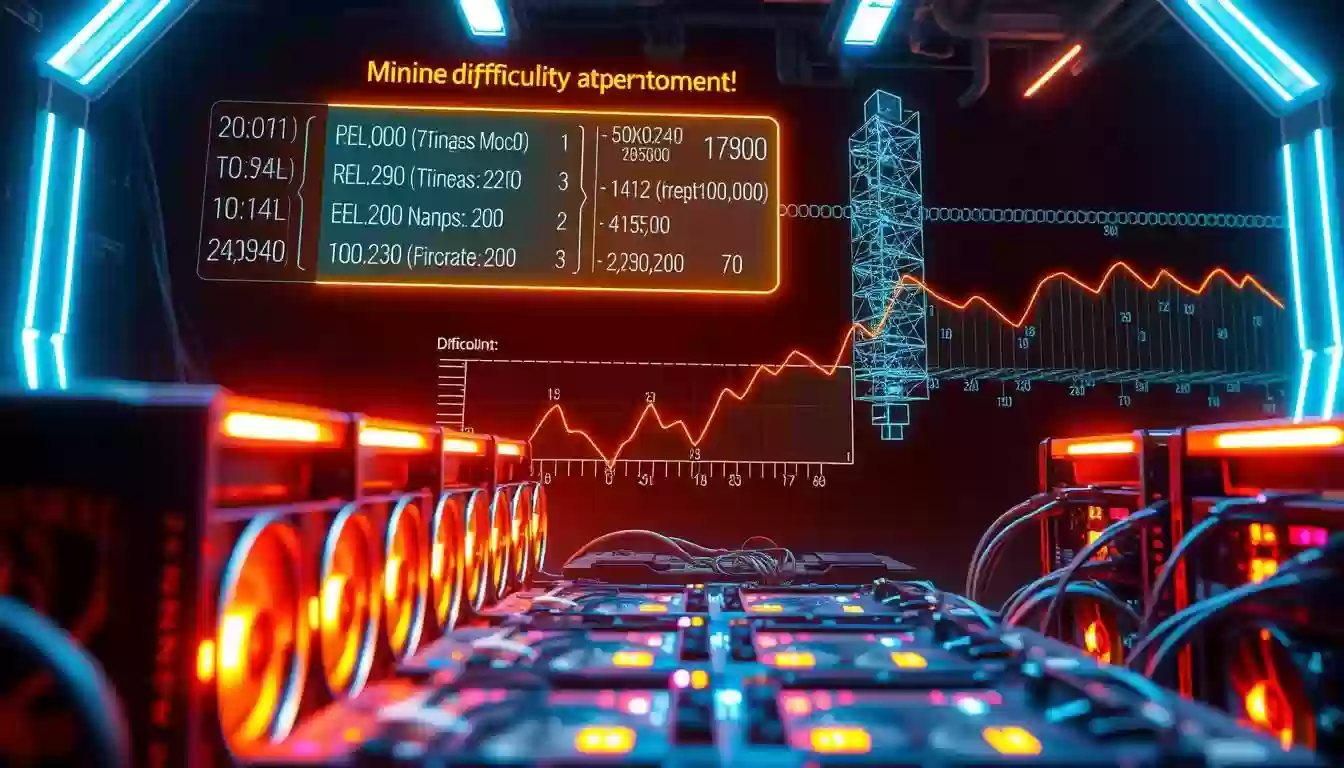Crypto Mining Difficulty Explained: Step-by-Step Guide
 02 Mar 25
02 Mar 25
Crypto mining difficulty is a critical factor in maintaining the integrity and security of blockchain networks. It ensures that adding new blocks to the blockchain is both challenging and consistent. This guide will walk you through the process step-by-step, making complex concepts accessible to everyone.
In blockchain networks like Bitcoin, miners compete to solve complex mathematical puzzles. This process, known as proof-of-work, secures the network and verifies transactions. The mining difficulty adjusts regularly to maintain a consistent block creation time of approximately 10 minutes.
Historically, mining evolved from using basic computer processors to specialized ASIC hardware. This evolution significantly increased the hash rate, making the network more secure. Understanding how mining difficulty works is essential for grasping the mechanics and security of blockchain technology.
Introduction to Cryptocurrency Mining
Cryptocurrency mining is the backbone of blockchain networks, enabling the secure creation and validation of transactions. This process involves solving complex mathematical puzzles to add new blocks to the blockchain, ensuring the network's integrity and security.
The Purpose of Mining in Blockchain
Mining serves two crucial functions: securing the network and verifying transactions. By competing to solve mathematical puzzles, miners validate transactions and create new blocks, which are then added to the blockchain. This decentralized process ensures the network's security without relying on a central authority.
Understanding Hash Rate and Block Generation
Hash rate measures the speed at which miners solve these puzzles. A higher hash rate means more attempts per second to find the correct solution, enhancing the network's security. The process involves finding a specific nonce, a unique number in each block, to generate a hash that meets the required criteria. This ensures a steady block creation time, typically around 10 minutes for Bitcoin.
| Hardware Type | Hash Rate | Power Consumption |
|---|---|---|
| CPU | Very Low | High |
| GPU | Low | Moderate |
| ASIC | Very High | Low |
Historically, mining transitioned from using basic computer processors (CPUs) to more efficient graphics processing units (GPUs) and finally to specialized Application-Specific Integrated Circuits (ASICs). This evolution significantly increased the network's hash rate, making it more secure. Understanding how mining difficulty works is essential for grasping the mechanics and security of blockchain technology.
Crypto Mining Difficulty Explained: Core Concepts
Mining difficulty is a cornerstone in the blockchain ecosystem, ensuring the network's stability and security. It serves as a critical parameter that adjusts the challenge miners face in finding new blocks, maintaining a consistent block creation time of approximately 10 minutes for Bitcoin. This adjustment compensates for changes in the network's hash rate and miner participation, ensuring the blockchain's integrity.
Defining Mining Difficulty and Its Importance
Mining difficulty is a numerical value that determines how hard it is for miners to find a valid hash for a new block. A higher difficulty means the network requires more computational power to solve the mathematical puzzles. This balance ensures that the block creation time remains steady, typically around 10 minutes for Bitcoin, despite advancements in technology.
How Difficulty Secures the Blockchain
The security of the blockchain relies heavily on mining difficulty. By adjusting the difficulty, the network ensures that adding new blocks remains challenging, preventing any single entity from easily manipulating the blockchain. The 2,016 block cycle is a key factor in this process, as it's the period after which the difficulty is adjusted to maintain network stability.

As more miners join the network or employ more powerful hardware, the hash rate increases. This necessitates a higher difficulty level to maintain the balance. This dynamic adjustment ensures the blockchain remains secure and resilient against potential attacks.
In summary, mining difficulty is vital for maintaining the blockchain's security and stability. It ensures that the network remains resilient, even as technology and miner participation evolve. By understanding how mining difficulty works, we gain insight into the intricate mechanics that safeguard the blockchain ecosystem.
How Mining Difficulty is Adjusted in the Blockchain
The adjustment of mining difficulty is a dynamic process that ensures the blockchain network remains stable and secure. This process is crucial for maintaining the balance between the time taken to mine new blocks and the overall security of the network.
Adjustment Algorithms and 2,016-Block Cycles
The difficulty adjustment algorithm is based on the time it takes to mine 2,016 blocks. If the average time is less than 10 minutes, the difficulty increases. Conversely, if it takes longer, the difficulty decreases. The formula used is:
T = actual time / 20,160 minutes
This ensures that the block creation time remains consistent, typically around 10 minutes for Bitcoin.
The Role of Network Hash Rate in Difficulty Changes
The network hash rate significantly influences difficulty adjustments. A higher hash rate means more computational power, leading to faster block creation and thus higher difficulty. Conversely, a lower hash rate results in slower block creation and decreased difficulty.
| Block Time | Difficulty Adjustment |
|---|---|
| Increases | |
| > 10 minutes | Decreases |
For example, if the average block time drops below 10 minutes, indicating a higher hash rate, the difficulty increases to slow down block creation. This adjustment ensures the network remains secure and efficient.
Miners must adapt to these changes by upgrading hardware or joining mining pools to remain profitable. Understanding these adjustments is key to grasping how the blockchain maintains its integrity and security.
The Impact of Mining Difficulty on Network Operations
Mining difficulty plays a pivotal role in shaping the operational efficiency of blockchain networks. As the difficulty increases, it directly influences key aspects such as block generation time, transaction speeds, and the overall cost of mining operations. Understanding these dynamics is crucial for grasping how networks maintain stability amidst evolving conditions.
Effects on Block Generation Time and Transaction Speeds
A higher mining difficulty extends the time required to generate new blocks. For instance, if the average block time drops below 10 minutes, the difficulty increases to slow down block creation. This adjustment ensures a consistent block generation time, typically around 10 minutes for Bitcoin. However, this increased difficulty can lead to slower transaction confirmation speeds, as each block can hold fewer transactions.
| Block Time | Difficulty Adjustment |
|---|---|
| Increases | |
| > 10 minutes | Decreases |
For example, if the average block time is less than 10 minutes, the difficulty increases to slow down block creation. Conversely, if it takes longer than 10 minutes, the difficulty decreases to hasten the process.
Implications for Mining Equipment and Energy Consumption
Higher mining difficulty necessitates more powerful and efficient mining hardware. Miners must invest in advanced ASICs to maintain profitability. This not only increases upfront costs but also raises energy consumption, as more powerful hardware requires more electricity to operate. According to recent data, Riot Platforms expanded its hash rate to 33.5 EH/s, highlighting the need for efficient equipment to handle higher difficulty levels.

The energy consumption implications are significant. As difficulty rises, miners may face higher operational costs, potentially leading to centralization as smaller operations struggle to compete. This underscores the importance of balancing operational costs with network performance to maintain profitability and security.
Strategies to Optimize Mining Operations
Optimizing mining operations is essential for maintaining profitability and efficiency in the ever-evolving blockchain landscape. By focusing on hardware upgrades, energy management, and collaborative strategies, miners can enhance their operations and stay competitive.
Upgrading Hardware for Improved Efficiency
One of the most effective ways to boost mining performance is by upgrading to high-efficiency ASICs (Application-Specific Integrated Circuits). These specialized devices are designed specifically for mining, offering significant improvements in hash rates compared to traditional CPUs or GPUs. For instance, Minerstat’s calculator can help miners assess the potential return on investment when switching to newer ASIC models, ensuring informed decisions that align with operational goals.
Optimizing Energy Consumption and Cost Management
Energy costs are a major factor in mining profitability. Miners can reduce their overhead by switching to renewable energy sources or investing in energy-efficient hardware. For example, using ASICs with lower power consumption can lead to notable savings. Additionally, regular maintenance and regular firmware updates can further enhance energy efficiency, ensuring that operations remain cost-effective without compromising performance.
Leveraging Mining Pools for Stable Earnings
Joining mining pools allows miners to combine their computational power with others, creating a more stable source of income. By pooling resources, participants share both the workload and the rewards, making it easier to compete with larger mining farms. This collaborative approach not only enhances earnings stability but also distributes risks more evenly among participants. For example, Riot Blockchain’s expansion to a hash rate of 33.5 exahash demonstrates how collective efforts can lead to significant operational improvements.
Historical Trends and Future Predictions
The journey of mining difficulty from its inception to today reveals a fascinating story of adaptation and growth. From humble beginnings with basic computer processors to the rise of specialized ASICs, the evolution of mining difficulty has been shaped by technological advancements and network demands.
Evolution of Mining Difficulty Over the Years
In the early days of Bitcoin (2010-2014), mining was relatively simple, with low difficulty levels. As more miners joined and hardware evolved, difficulty increased steadily. The 2016 halving event marked a significant shift, as the block reward reduction led to increased competition and higher difficulty levels.
Regulatory changes and technological milestones, such as the introduction of ASICs, have further influenced difficulty. These factors have driven the network to become more secure and resilient, adapting to the growing number of participants.
Anticipating Post-Halving Adjustments and Future Shifts
Looking ahead, the upcoming halving events are expected to impact miner behavior significantly. Experts predict higher difficulty levels as the block reward decreases, potentially leading to consolidation among miners. Advances in AI and renewable energy may also reshape mining operations, offering more efficient and sustainable solutions.
Miners are advised to adopt flexible strategies, investing in efficient hardware and exploring renewable energy sources to maintain profitability. By understanding these trends, miners can better navigate the evolving landscape and capitalize on emerging opportunities.
Conclusion
Mining difficulty is a critical factor in maintaining the integrity and security of blockchain networks, ensuring consistent block creation time. This guide has explored how difficulty adjustments maintain the balance of block generation, the strategies miners can use to adapt, and the importance of understanding historical trends and future predictions.
By focusing on hardware upgrades, energy management, and collaborative strategies, miners can enhance their operations and stay competitive. Understanding mining difficulty is essential for grasping the mechanics and security of blockchain technology. For those looking to delve deeper, additional resources like Bitcoin Mining Difficulty Explained provide comprehensive insights.
In conclusion, this guide has clarified complex topics in simple terms, guiding readers through the intricate world of mining difficulty. We encourage further exploration and learning to fully understand the evolving landscape of blockchain technology.
FAQ
How often is the mining difficulty adjusted in the Bitcoin network?
The mining difficulty in the Bitcoin network is adjusted every 2,016 blocks, which typically takes around two weeks. This adjustment ensures the network maintains a consistent block time of approximately 10 minutes.
What factors influence changes in the network hash rate?
The network hash rate can change based on the number of miners joining or leaving the network, advancements in mining hardware, and variations in energy costs. These factors directly impact the overall mining power and efficiency.
How does mining difficulty affect the energy consumption of the Bitcoin network?
Higher mining difficulty often requires more powerful hardware and increased energy use to solve complex mathematical puzzles. This can lead to higher energy consumption, emphasizing the importance of efficient hardware and sustainable energy sources.
What happens when a new block is mined in the blockchain?
When a new block is mined, it is added to the blockchain, verifying transactions and securing the network. This process also resets the timer for the next block, maintaining the network's intended block time.
Can individual miners adjust the mining difficulty level?
No, mining difficulty is automatically adjusted by the network based on the total hash rate. Miners can, however, optimize their operations by upgrading hardware or joining mining pools to improve efficiency and earnings.
How does the proof-of-work system impact the security of the blockchain?
The proof-of-work system requires significant computational power to validate transactions, making it highly secure. This ensures that altering the blockchain is computationally infeasible, protecting the network from attacks.
What role does the 2,016-block cycle play in difficulty adjustment?
The 2,016-block cycle is the period after which the network evaluates the total hash rate and adjusts the difficulty. This ensures the blockchain maintains a stable block time, regardless of changes in mining power.
How do miners handle changes in mining difficulty?
Miners may upgrade their hardware, join mining pools, or optimize energy use to remain profitable during difficulty changes. These strategies help miners adapt to the network's evolving requirements.
What is the significance of the network hash rate in mining?
The network hash rate measures the total computational power of the network. A higher hash rate increases security but also raises the mining difficulty, balancing the network's efficiency and security.
How does mining difficulty affect transaction processing time?
Mining difficulty primarily affects block creation time. Higher difficulty may slow block creation, but the network aims to maintain an average block time of 10 minutes, ensuring consistent transaction processing.





























